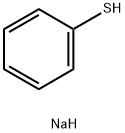Preparation
Sodium thiophenolate is prepared by the following steps:A solution of (11) ( 1.0 g, 2.8 mmol), phenylthiol (0.33 g, 3.0 mmol), acetonitrile (5 cm3) and sodium carbonate (0.3 g) was stirred under reflux for 19 h. Water (20 cm3) was added, then the mixture extracted into DCM. The DCM solution was dried (MgS04) and evaporated to dryness. Chromatography on silica gel with DCM - hexane (30 : 70) as the eluent yielded 2,6-dibromo-3,5-difluoro-4-thiophenoxypyridine (0.9 g, 85%), m.p.65.5-66.5 OC (Found: C, 34.45; H, 1.3; N, 3.2. C11H5Bf2F2NS requires C, 34.7; H, 1.3; N, 3.7%); IR spectrum no. 16; mass spectrum no. 19; nmr spectrum no. 16.
Uses
Sodium thiophenolate has been used for the synthesis of MCoTI-I and MCoTI-II cyclotides, which are naturally-occurring cyclic cystine-knot microprotein trypsin inhibitors. It may be employed in the following studies:
- As probe for the immunoassay and for the detection of label-free protein by surface-enhanced Raman scattering (SERS).
- Preparation of new cyclometalated 6-phenyl-4-(p-R-phenyl)-2,2′-bipyridyl (C--N--N)Pt(II) thiophenolate complexes.
- Synthesis of 1,3,5,7,9-pentakis(4-methoxyphenylthio)corannulene, 1,3,5,7,9-pentakis(2-naphthylthio)corannulene and 1,3,6,8-tetrakis(4-methoxyphenylthio)corannulene.
- Synthesis of Et4N+ salts of homoleptic arylthiolate Ti(IV) complex, [Ti(SPh)6]2-.

